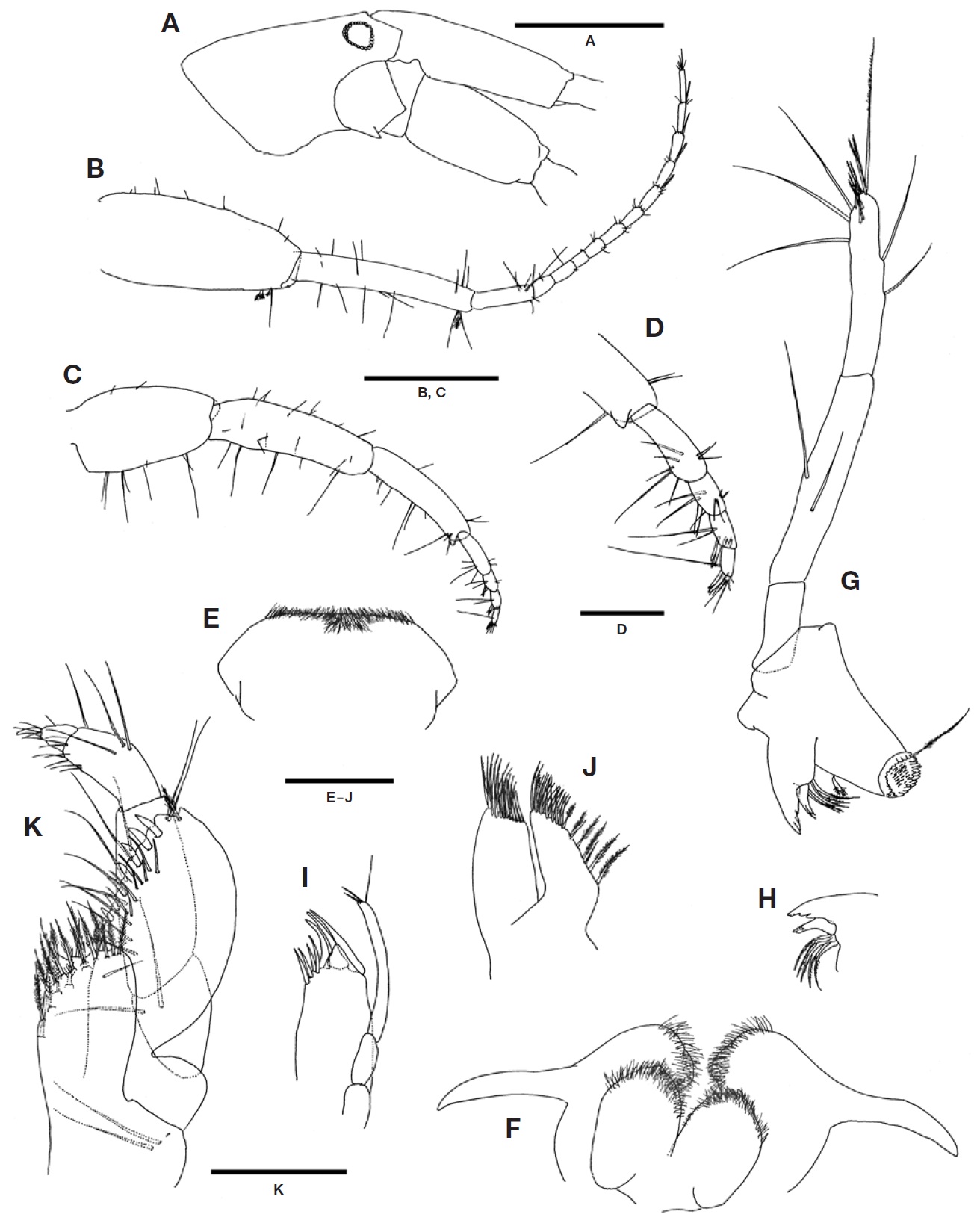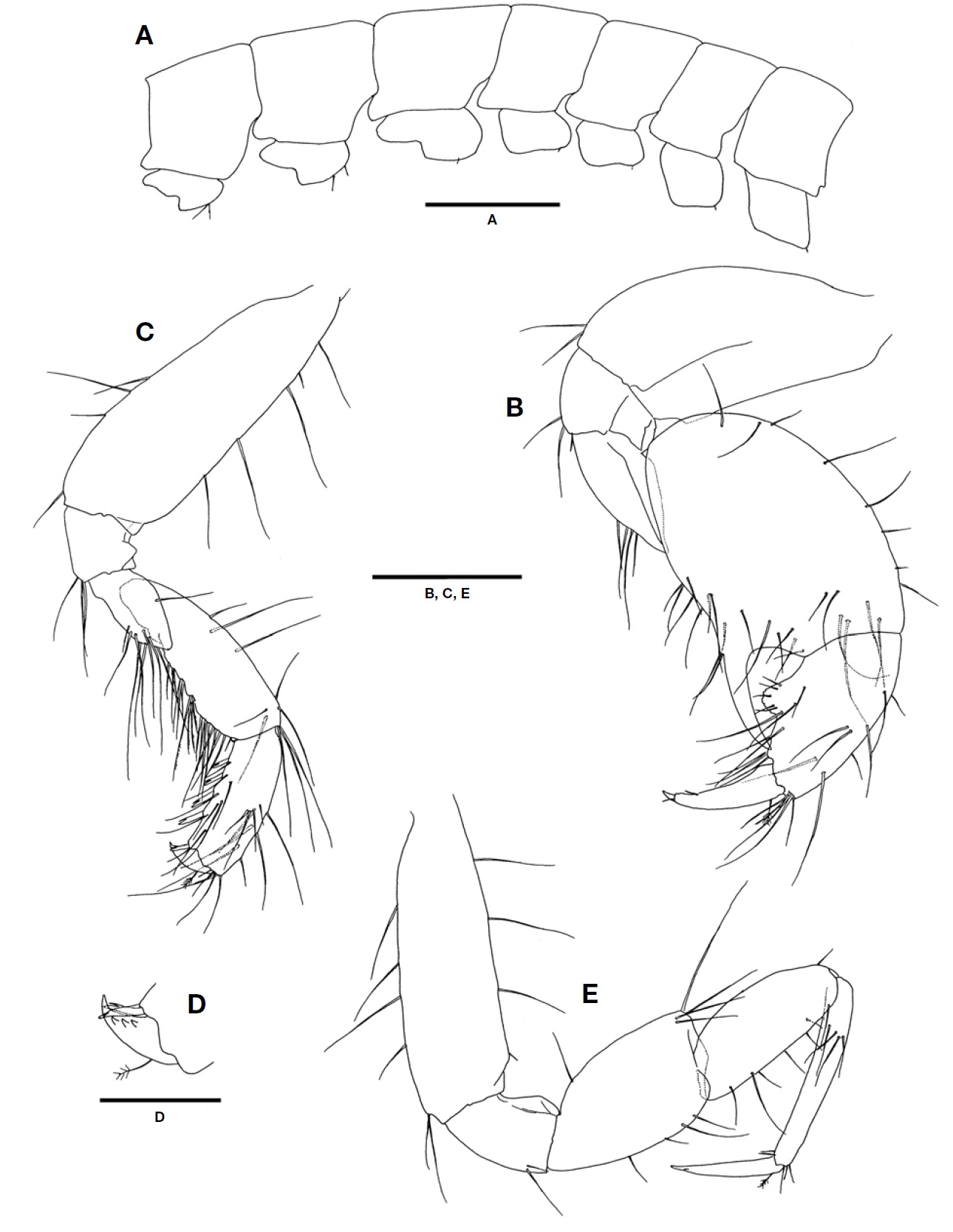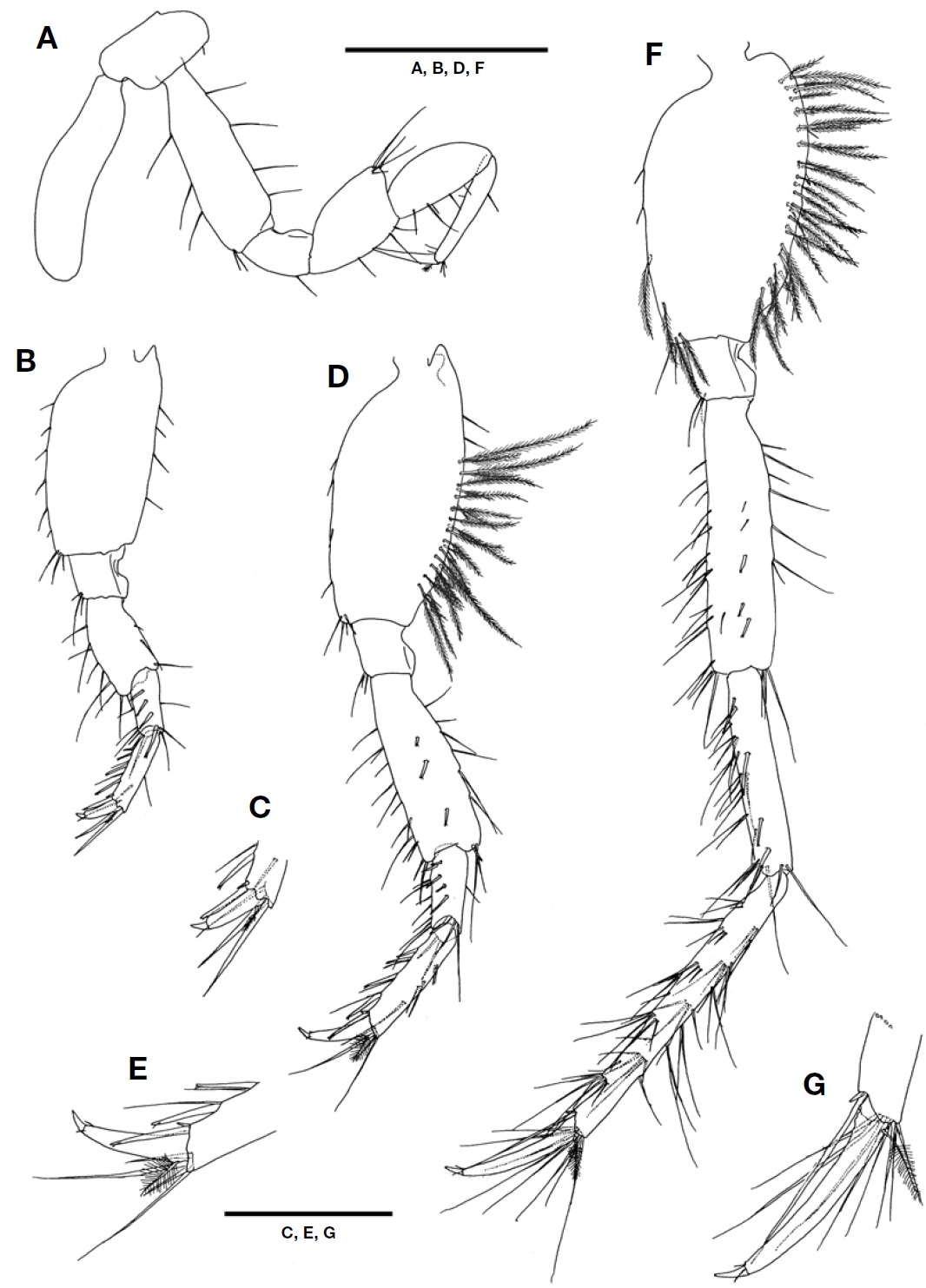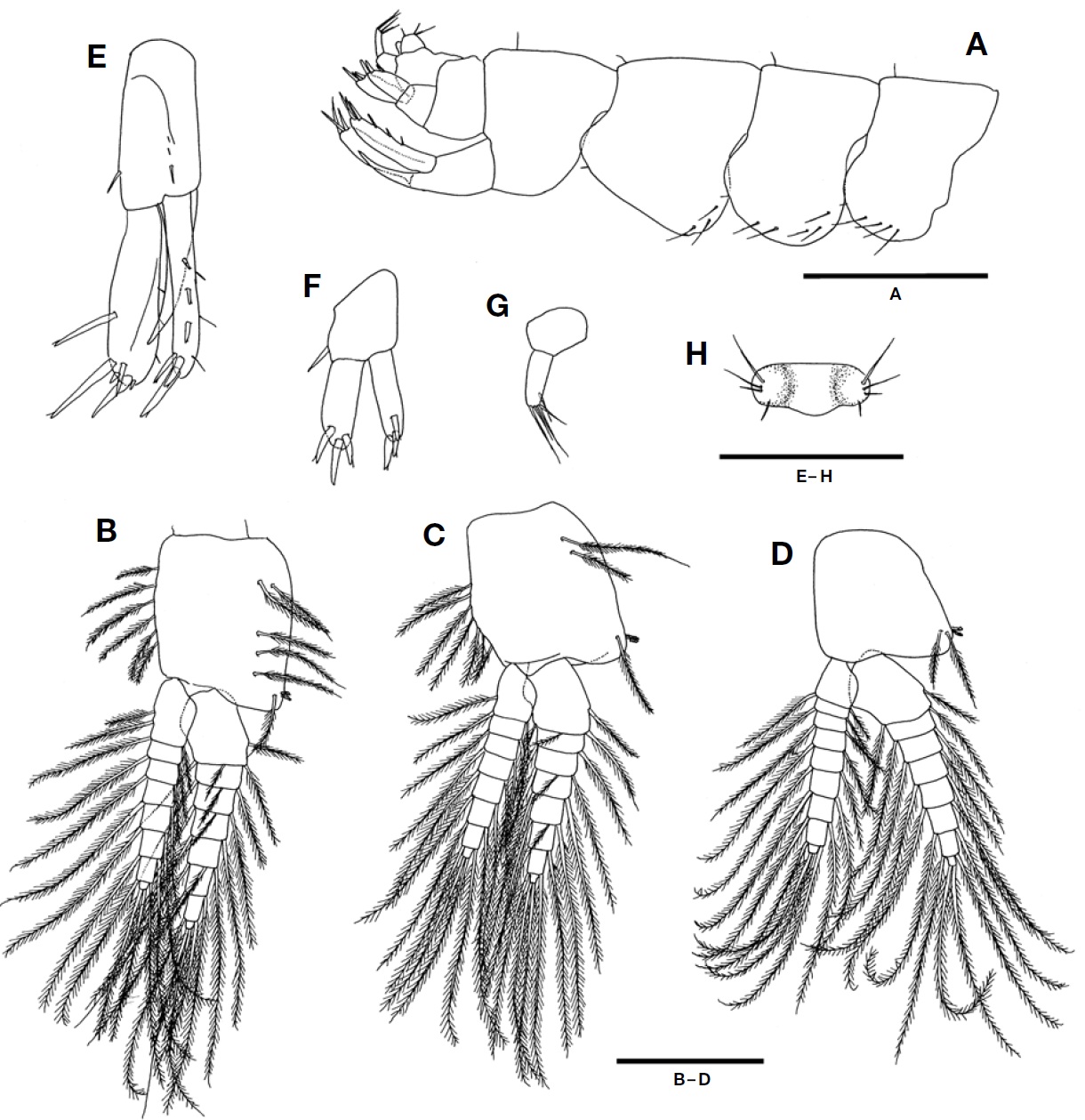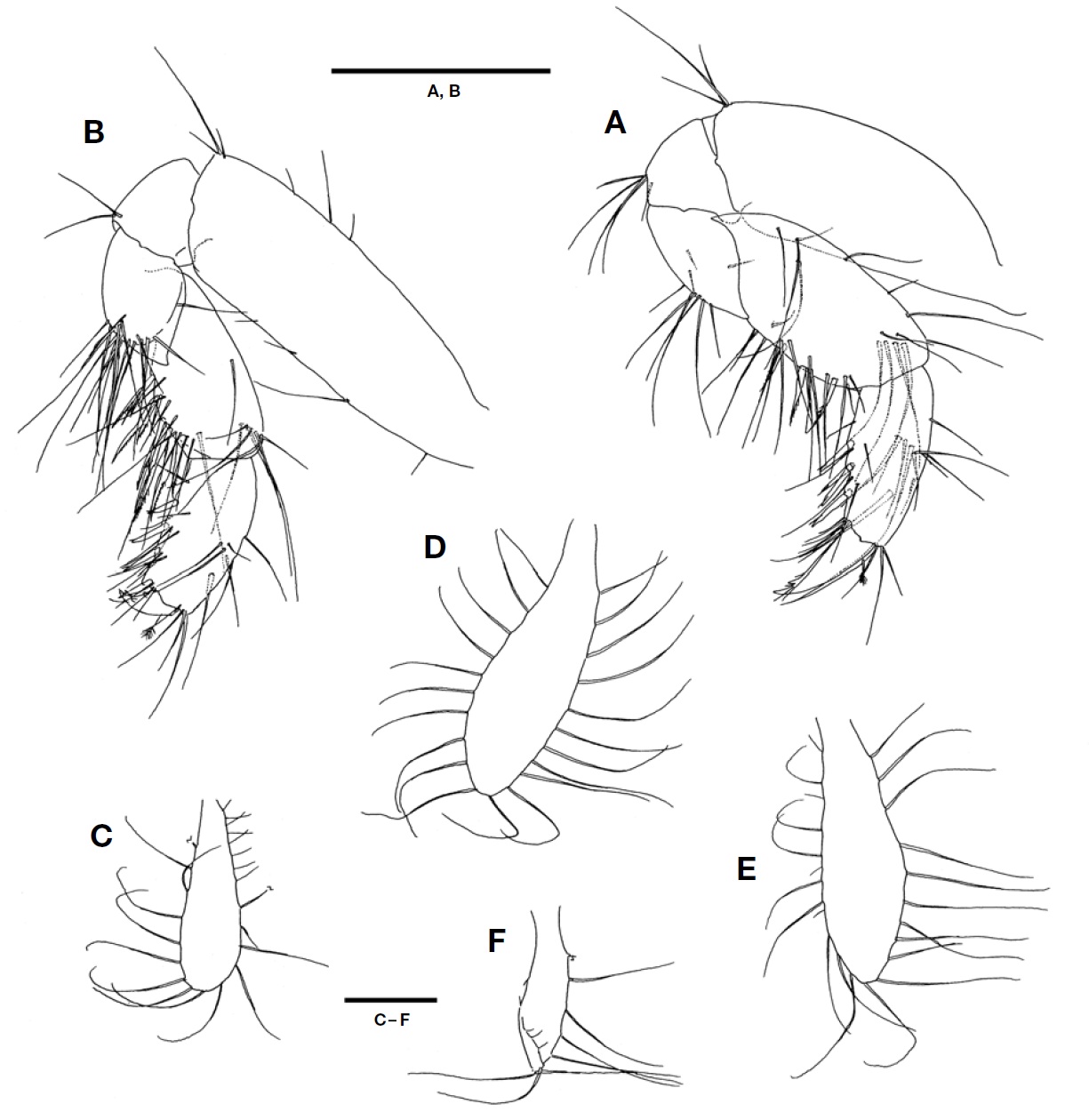



A newly recorded aorid species, Paragrandidierella minima Ariyama, 2002, from Korean waters is reported with a description and illustrations, and its generic features are considered. This species is characterized by the carpochelate gnathopod 1 in matured male, the posterodistal protrusion on peduncle 5 of antenna 2, the absence of the apical spine on inner plate of maxilliped, the minute apical projection on inner lobe of lower lip, the acute posteroproximal extension on the basis of each pereopod 5 and 6, the shape of uropods and telson, and the large inter-ramal process of uropod 1. This is the first report of the genus Paragrandidierella from Korea.
The monotypic genus
Samples were collected by washing of algae using sieve in the muddy intertidal zone. Specimens were fixed initially with 5% formaldehyde-seawater solution, and preserved with 85% ethyl alcohol after sorting in the laboratory. The appendages of specimens were dissected in a petri dish filled with glycerol, using dissection pincer and needle under the stereomicroscope (SZH10; Olympus, Tokyo, Japan), and mounted on temporary or permanent slide. Drawings and measurements were performed by light microscope (LABOPHOT-2; Nikon, Tokyo, Japan) with the aid of a drawing tube.
Order Amphipoda Latreille, 1816
Suborder Gammaridea Latreille, 1803
Family Aoridae Stebbing, 1899
1*Genus Paragrandidierella Ariyama, 2002
2*Paragrandidierella minima Ariyama, 2002 (Figs. 1-5)
Material examined. Korea: 4♂♂, 2♀♀, Jeollanam-do, Wando-gun, Soan-myeon, Bija-ri, 12 May 2010, Jung TW.
Description. Male: Body subcylindrical, about 5.7 mm long.
Rostrum indistinct; anterior cephalic lobe slightly produced; inferior antennal sinus large, concave; eyes small (Fig. 1A). Coxae separated (Fig. 2A). Each pleon 1-3 and urosome 1 with a dorsal seta, respectively; pleonal epimeron 1 subrounded, with a setule on posteroventral corner and 4 long setae near ventral margin; pleonal epimeron 2 similar to pleonal epimeron 1 in shape but slightly larger, with 5 long setae near ventral margin; pleonal epimeron 3, ventral margin oblique, with 1 setule on posteroventral corner, and 3 long setae near anteroventral corner (Fig. 4A).
Antenna 1 (Fig. 1B) longer than antenna 2; length ratio of peduncles 1-3 1.00 : 0.86 : 0.29; peduncle 1 convex and robust, with 3 small plumose setae near posterodistal corner; peduncle 2 slender, with 1 plumose seta near posterodistal corner; peduncle 3 short; accessory flagellum absent; flagellum shorter than peduncles 1, 2 and 3 combined in length, composed of 12 articles, last one considerably reduced, each 5 distal article except last one with an aesthetasc, respectively.
Antenna 2 (Fig. 1C, D). Peduncles 3-5 stout, length ratio 1.00 : 1.17 : 0.91; peduncle 5 with 1 small projection on posterodistal corner; flagellum shorter than peduncle 5, composed of 5 articles, last one considerably reduced, 2nd article with 1 spine on posterior margin, 3rd and 4th articles with a pair of spines on posterodistal margin, respectively.
Upper lip (Fig. 1E) subhexagonal in shape, apical margin with fine bristles distally.
Lower lip (Fig. 1F) with long mandibular processes; apical margin of inner and outer lobe densely pubescent distally; inner lobe with 1 minute apical projection.
Right mandible (Fig. 1G). Incisor 4 dentate; lacinia mobilis bifid; 5 elongate accessory blades pectinate; molar process well developed, with 1 long plumose seta, and 1 branched plumose seta on basal part; palp composed of 3 articles, 1st article short, 2nd article beyond twice of 1st article in length, with 2 setae on medial surface, 3rd article shorter than 2nd, with 3 inner and 2 outer long setae, apical surface lined with 7 short pectinate setae, apex with 1 long pectinate seta.
Left mandible (Fig. 1H). Incisor 3 dentate; lacinia mobilis lined with several minute teeth apically; 5 elongate accessory blades pectinate.
Maxilla 1 (Fig. 1I). Outer lobe, apical margin with 1 large triangular projection, lined with 3 stout and 4 slender spines; palp 2-articulate, 1st article short, 2nd article slender, apex beyond spines of outer plate, with 3 setae apically.
Maxilla 2 (Fig. 1J). Inner lobe, apical margin slightly produced, with many setae, inner margin with 6 plumose and 2 normal setae; outer lobe with numerous setae on apical and subapical margin.
Maxilliped (Fig. 1K). Inner lobe subquadrate, inner distal corner produced, apical margin with several plumose setae but lacking spines, surface near the distal margin with 1 roundish row composed of several plumose setae; outer lobe semicircular in shape, largely expanded, apex slightly notched, inner margin lined with 7 spines that successively increasing in length, palp composed of 4 articles, 1st article short, obliquely truncated apically, 2nd article gradually diminished distally in width, 4th article with 1 stout apical spine.
Gnathopod 1 (Fig. 2A, B) larger than gnathopod 2, carpochelate; coxa lozenge in shape, with 1 small seta on anteroventral corner; basis, anterior margin slightly hollow, posterior margin convex, with 2 distal setae; ischium large, with an anterior lobe; merus subtriangular pyramid shaped, with 4 setae on posterior margin; carpus enlarged, anterior margin plumpy, rounded, with several setae, posterior margin with enlarged acute projection; propodus small, anterior margin 1/2 length of carpus, posterior margin with blunt projection medially; dactylus falcate.
Gnathopod 2 (Fig. 2A, C, D). Coxa slightly smaller than that of gnathopod 1, anterior margin rounded, with 1 small seta on anteroventral corner; basis more slender than that of gnathopod 1, anterior margin a little convex, with 4 long and 1 short setae, posterior margin somewhat dilated distally, with 3 medial and 1 distal setae; ischium with a small anterior lobe; merus produced posterodistally, with several long setae on posterodistal margin; carpus beyond half of basis in length, anterior margin convex, posterior margin lined with several groups composed of pectinate setae; propodus subrectangular in shape, shorter than carpus, posterior margin lined with 4 stout spines, palm transverse, defined by a pair of inner and outer spines; dactylus short, surface with 3 protrusions, tip curved.
Pereopod 3 (Fig. 2A, E). Coxa smaller than that of gnathopod 2, anterior margin rounded; basis subtrapezoidal, slightly dilated posterodistally, anterior margin with 3 long and 1 short setae, posterior margin with 4 long medial and a pair of distal setae; ischium medium in size, with an anterior lobe; merus expanded, beyond 1/2 of basis in length, anterodistal corner with a group of 4 long setae; carpus equal to merus in length, anterior margin slightly swollen medially, posterior margin with several setae; propodus slender, somewhat longer than carpus; dactylus elongate, 1/2 of propodus in length, with a small protrusion near the tip.
Pereopod 4 (Figs. 2A, 3A) nearly similar to pereopod 3, except more roundish anterior margin of coxe.
Pereopod 5 (Figs. 2A, 3B, C). Coxa, anterior margin rounded, posterovental corner concave, posterior margin about half of anterior margin in width; basis large, subrectangular in shape, anterior margin slightly convex, lined with 6 normal setae, posteroproximal corner produced proximally; ischium with a posterior lobe; merus dilated distally, anterior margin more convex than posterior margin, lined with 9 setae; carpus subquadrate in shape, shorter than merus, surface with 4 elongate spines; propodus slightly longer than carpus, anterior margin lined with 4 spines, anterodistal corner with a pair of elongate and small spines, posterodistal corner with a set of 3 elongate setae; dactylus somewhat straighten, inner distal
margin with 1 small roundish protrusion.
Pereopod 6 (Figs. 2A, 3D, E) more than 1.5 times as long as pereopod 5; coxa similar to that of pereopod 5 in shape but slightly smaller; basis, anterior and posterior margin convex, posteroproximal corner produced proximally, inner and outer surface near posterior margin lined plumose setae; ischium
with a posterior lobe; merus dilated posterodistally, anterior and posterior margin lined with numerous setae, surface with 3 spines, posterodistal corner with 1 spine and 2 long setae; carpus subquadrate, small, 1/2 of merus in length, surface with 5 spines, inner and outer distal corner with stout setae; propodus longer than carpus, anterior margin lined with 4 spines, anterodistal corner with a pair of elongate and small spines, posterodistal corner with 2 elongate and 2 normal stout setae; dactylus beyond 1/2 of propodus.
Pereopod 7 (Figs. 2A, 3F, G) about 1.6 times as long as pereopod 6; coxa similar to that of pereopod 6 in shape but slightly smaller; basis, anterior margin convex, with 2 short and 2 plumose setae medially, and 2 long and 2 plumose setae on distal corner, posteroproximal corner somewhat dilated proximally, but not acute, posterior margin rounded, with 5 short spines, inner and outer surface near posterior margin lined plumose setae; ischium with a posterior lobe; merus subrectangular, anterior margin with numerous setae, surface bearing 3 spines and 3 short setae; carpus slender, shorter than merus, anterior margin with numerous setae,
surface with 5 spines; propodus slender, elongate, about 1.6 times as long as carpus, with several set of numerous setae, anterodistal corner with a pair of elongate and small spines; dactylus slender, shorter than 1/2 of carpus.
Pleopod 1 (Fig. 4B). Peduncle stout, but short, quadrate in shape, outer margin with 6 medial plumose setae, 5 medial plumose setae near inner margin, a pair of toothed spines and 1 plumose seta near inner distal corner; rami longer than peduncle, inner ramus slightly longer than outer ramus.
Pleopod 2 (Fig. 4C). Peduncle slightly dilated inner distally; outer margin with 7 medial plumose setae, 2 plumose setae near inner surface; a pair of toothed spines and 1 plumose seta near inner distal corner; rami longer than peduncle, inner ramus slightly longer than outer ramus.
Pleopod 3 (Fig. 4D). Peduncle, inner distal corner more dilated, with a pair of spines and 2 plumose setae.
Uropod 1 (Fig. 4E). Peduncle reduced, inner lateral margin with 1 spine, outer lateral margin with a spine and 2 minute setae, ventrodistal margin with 1 large inter-ramal process; inner ramus with a long dorsomedial spine, a pair of distalo-most spines composed of a large and a normal one, apex rounded, with 1 large and 2 small spines; outer ramus with 3 medial and a pair of distalomost spines, apex rounded, with 1 large spine.
Uropod 2 (Fig. 4F). Peduncle short, proximal margin oblique, inner margin with 1 spine; inner and outer rami with 2 distalomost and 1 distal spines, respectively.
Uropod 3 (Fig. 4G) uniramus; peduncle short; ramus with 4 apical and 1 distalomost setae.
Telson (Fig. 4H), apex somewhat produced, both lateral surface with rounded swellings bearing 4 setae, respectively.
Female: Body about 3.1 mm long.
Gnathopod 1 (Fig. 5A) subchelate; basis subtrapezoidal, anterior margin straighten, with 1 medial seta, posterior margin convex, with a set of 3 distal setae; ischium with an anterior lobe; merus subtriangular in shape, posterior margin rounded, with 6 medial setae; carpus normal, 0.8 times as long as basis, anterior margin slightly rounded, with several setae, posterior margin lined with 3 thick pectinate and several long setae; propodus shorter than carpus, posterior margin with 1-2-1 spines in formula, palm indistinct; dactylus stout, with 2 small projections near inner apex.
Gnathopod 2 (Fig. 5B) also subchelate; basis slender and longer than that of gnathopod 1, posterior margin somewhat dilated distally, with 3 medial and a set of 3 distal setae; ischium with a small anterior lobe; merus, posterodistal corner acutely produced, half of posterodistal margin and surface with numerous long setae; carpus beyond 1/2 of basis, posterior margin lined with several groups composed of pectinate and long setae; propodus subrectangular, shorter than carpus, posterior margin lined with 3 spines and 1 defining spine, palm transverse; dactylus short, with a small projection near inner apex, surface with 2 protrusions, tip curved.
Oostegites (Fig. 5C-F) somewhat narrow; oostegites of pereopod 3 and 4 larger than those of gnathopod 2 and pereopod 5.
Remarks. The genus
On the other hand, Korean specimens of
Korean name: 1*짧은육질꼬리옆새우속 (신칭), 2*짧은육질꼬리옆새우 (신칭)
